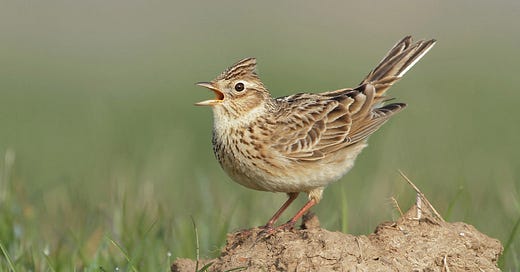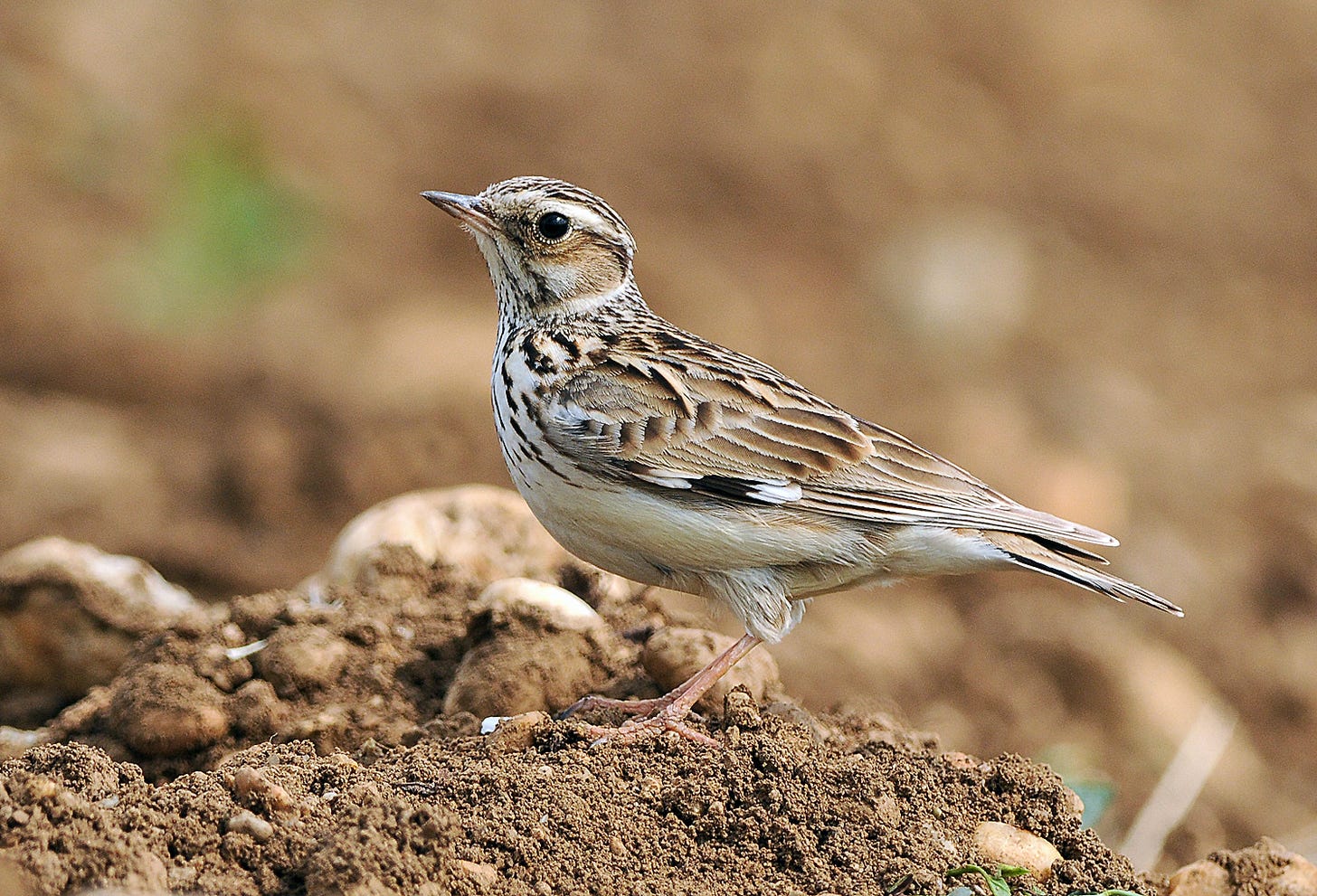No bird inhabits the heavens like a skylark. The source of the song is often a mere speck, hovering way up, as if suspended, and eluding us grounded observers.
How many minor neck injuries have been sustained while attempting to locate a skylark against a cloudless sky?
Skylarks are generous with their song, unspooling it at epic length. Birds have been recorded singing for twenty minutes without a break.
In Birds Britannica, Mark Cocker and Richard Mabey suggest that the skylark has inspired more poetry than any bird but the nightingale.
The notes are famously described by poet George Meredith in The Lark Ascending as a ‘silver chain of sound / Of many links without a break / In chirrup, whistle, slur and shake’.
Those lines are from the poem that inspired the composition by Ralph Vaughan Williams of the same name. And - surely - Josh Wink’s Higher State of Consciousness (listen from 3 minutes 33 seconds in for maximum skylark transcendence).
Most songbirds avoid the dangers of the open sky in their territorial activities, but larks revel in it. An individual skylark may even continue to sing as they are pursued by a falcon, seemingly as a display of strength.
As a species, skylarks sing rather less strongly than they once did in Britain. Their numbers dropped dramatically in the second half of the twentieth century, as many of their preferred habitats - rough pasture, spring-sown crops and winter stubbles - were replaced with more intensive, year-round farming regimes.
However, they are still widespread, and thought to number around one and a half million pairs. The most recent surveys indicate they have bounced back in some parts of the country too.
The season for their song is virtually unbroken, and they are among the songbirds most likely to be heard in the sunshine in midwinter or late summer, when open landscapes can be otherwise rather quiet.
In winter, they can be encountered in down-to-earth flocks, perhaps a few dozen strong. In these circumstances they tend to appear as anonymous ‘little brown jobs’, typically poking around in low vegetation with their heads down. The crest on the their head - distinctive when seen well - is often held flat, and may be hardly noticeable at all.
However, they do emit a melodious little chatter as they are flushed. You might hear it as a fragment of the burbling phrases that you can make out within the song.
It’s a helpful aid to identification - albeit no substitute for the full freewheeling song that George Meredith described as ‘the tongue of the heavens’.
O skylark! I see thee and call thee joy!
Thy wings bear thee up to the breast of the dawn;
I see thee no more, but thy song is still
The tongue of the heavens to me!
Good lark separating from: Woodlark
🔗 Link of the week
The Stubborn Light of Things - in 2020, Melissa Harrison recorded a nature podcast series from her home in Suffolk that became a deep source of connection for many in lockdown. I caught one of the episodes again recently, by chance, in which the author combs her local lanes for a barn owl. It remains companionable, astute, soulful listening.
Thanks for reading Shriek of the Week. It’s off-brand I realise, but I slow down with the birdsong, and emails are now monthly until Christmas. Weekly output resumes in the New Year.
In the meantime, do plunder the archive, and if you’d like to listen to narrated versions, and/or to join me for some monthly live bird listening via Zoom, you can become a paid subscriber for £25 a year, or £5 a month.
Enjoy the birds.
~ Charlie
Media credits:
Skylark image by Neil Smith via Flickr, reproduced under CC licence CC-BY-SA 2.0
Woodlark image by Ján Svetlík via Wikipedia reproduced under CC licence CC-BY-SA 4.0






For anyone who liked The Stubborn Light of Things, Melissa Harrison has just launched a Substack, called Witness Marks, which has very much the same feel but in Substack form.
So cheerful and determined!